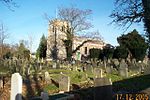Chandos Mausoleum
Buildings and structures completed in 1735Buildings and structures in the London Borough of HarrowChurches preserved by the Churches Conservation TrustJames Gibbs buildingsMausoleums in England ... and 1 more
Monuments and memorials in London

The Chandos Mausoleum is an early 18th-century English Baroque building by James Gibbs in the care of the Churches Conservation Trust. The mausoleum is attached to the north side of the church of St Lawrence Whitchurch in the London Borough of Harrow, England. The church including the mausoleum is recorded in the National Heritage List for England as a designated Grade I listed building.
Excerpt from the Wikipedia article Chandos Mausoleum (License: CC BY-SA 3.0, Authors, Images).Chandos Mausoleum
St Lawrence Close, London Stanmore (London Borough of Harrow)
Geographical coordinates (GPS) Address Nearby Places Show on map
Geographical coordinates (GPS)
| Latitude | Longitude |
|---|---|
| N 51.60838 ° | E -0.28931 ° |
Address
St Lawrence, Little Stanmore
St Lawrence Close
HA8 6RB London, Stanmore (London Borough of Harrow)
England, United Kingdom
Open on Google Maps






